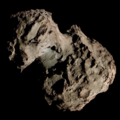External links
- 266P/Christensen at the JPL Small-Body Database
- 266P/Christensen at Seiichi Yoshida's website
| Numbered comets | ||
|---|---|---|
| Previous 265P/LINEAR | 266P/Christensen | Next 267P/LONEOS |
| | This comet-related article is a stub. You can help Wikipedia by expanding it. |

